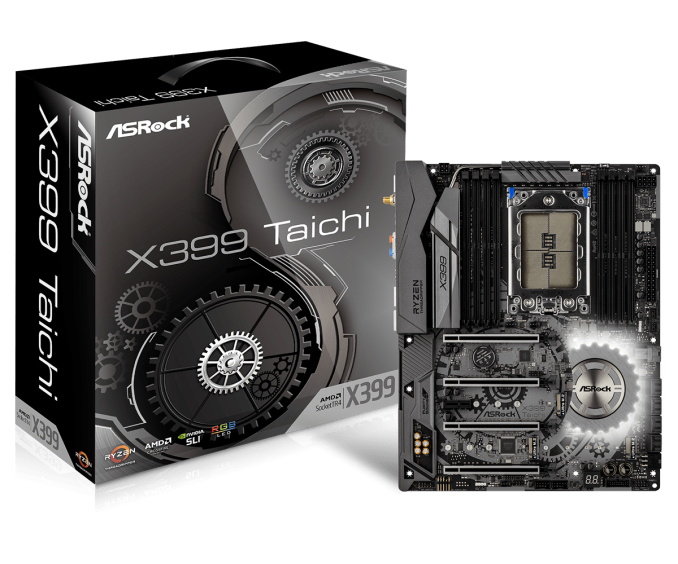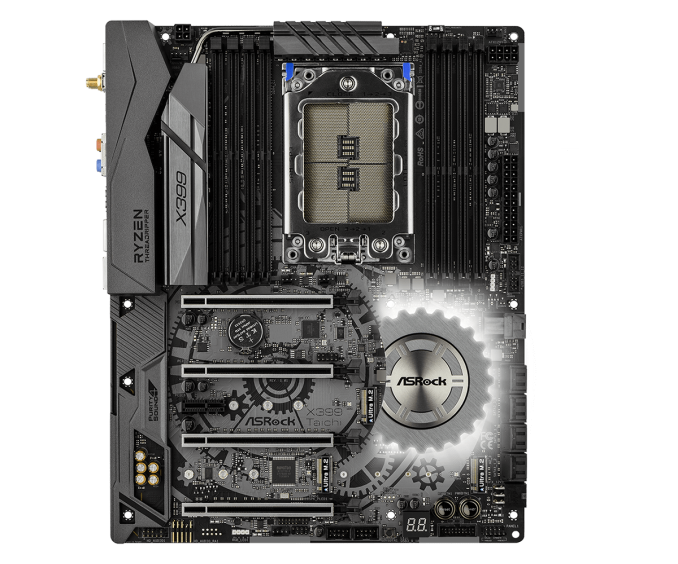An AMD Threadripper X399 Motherboard Overview: A Quick Look at Seven Products
by Ian Cutress & Joe Shields on September 15, 2017 9:00 AM ESTASRock X399 Taichi
The X399 Taichi is configured at a lower point down the ASRock product stack from the Professional Gaming. The Taichi forgoes 10 Gigabit Ethernet, and instead of the Creative Sound Blaster Cinema 3 suite for audio the Taichi uses Purity Sound 4 and a Realtek ALC1220 Codec.
Normally we associate ASRock’s Taichi models with black and white, but this time ASRock has made the board white and grey and drawing attention to the fact that the LEDs can be white if needed. So this means the X399 Taichi has a black PCB with gray accents in the shape of cogs on the PCB area between the PCIe slots and around the chipset heatsink. The DRAM slots are black, while the dual heatsinks for the VRM stretch around to the rear IO via a heatpipe are gray. Much like the Professional Gaming, the only integrated RGB LEDs are under the chipset heatsink, although there are two RGB LED headers for connecting additional RGB strips, all of which can all be controlled by the RGB LED application bundled with the board.
Just like the Professional Gaming, the Taichi supports up to 4-Way SLI and 4-Way Crossfire, with the PCIe slots reinforced using ASRock’s ‘Steel Slot’ protection. From top to bottom, the PCIe slots offer x16/x8/x16/x8 connectivity, taking 48 of the 60 PCIe lanes from the chipset. The final twelve are dedicated to storage with three onboard PCIe 3.0 x4 M.2 slots, one of which is switched with a U.2 connector. Other storage connectivity comes from eight SATA ports, supporting RAID 0/1/10.
The X399 Taichi uses two Intel I211AT gigabit Ethernet controllers, as well as an Intel 3168 1x1 802.11ac WiFi module.
In an almost copy-paste of the Pro Gaming, the Taichi uses the same digital 11 phase IR solution, along with the same EPS placement on the board. USB connectivity on the Taichi is the same as well, with three USB 3.1 (10 Gbps) Type-A ports on the rear panel, one USB 3.1 (5 Gbps) Type-C port on the rear panel, two onboard USB 3.1 (5 Gbps) headers for the front panel, and two USB 2.0 headers as well.
| ASRock X399 Taichi | |
| Warranty Period | 3 Years |
| Product Page | Link |
| Price | $339.99 |
| Size | ATX |
| CPU Interface | TR4 |
| Chipset | AMD X399 |
| Memory Slots (DDR4) | Eight DDR4 Slots, up to 3600 MT/s Supporting 128GB Quad Channel |
| Network Connectivity | 2 x Intel I211AT GbE |
| Wireless Network | 802.11 ab/g/n/ac Dual-Band (2.4/5 GHz) Bluetooth 4.2 |
| Onboard Audio | Realtek ALC1220 |
| PCIe Slots | 4 x PCIe 3.0 (x16/x8/x16/x8) from CPU 1 x PCIe 2.0 x1 from Chipset |
| Onboard SATA | 8x Supporting RAID 0/1/5/10 |
| Onboard SATA Express | None |
| Onboard M.2 | 3 x PCIe 3.0 x4 - NVMe or SATA |
| Onboard U.2 | 1 x PCIe 3.0 x4 (disables M2_1 when in use) |
| USB 3.1 | 1 x Type-A, 1 x Type-C (Rear Panel) |
| USB 3.0 | 8 x Rear Panel, 4x via internal headers |
| USB 2.0 | 4 x via internal headers |
| Power Connectors | 1 x 24-pin ATX 1 x 8-pin CPU |
| Fan Headers | 1 x CPU (4-pin) 1 x CPU Opt/Water Pump (4-pin) 2 x Chassis (4-pin) 1 x Chassis Opt/Water Pump (4-pin) |
| IO Panel | 2 x Antenna Ports 1 x PS/2 Mouse/Keyboard Port 1 x Optical SPDIF Out Port 1 x USB 3.1 Type-A Port 1 x USB 3.1 Type-C Port 8 x USB 3.0 Ports 4 x USB 3.0 Ports 2 x RJ-45 LAN Ports w/ LED 1 x BIOS Flashback Switch HD Audio Jacks |















99 Comments
View All Comments
nathanddrews - Friday, September 15, 2017 - link
The ROG Zenith has all the networking IO I want, but is lacking in SATA ports. Hmm...tarqsharq - Friday, September 15, 2017 - link
With all those extra PCI-E lanes you can just use add-in boards for anything you need more of.Gothmoth - Friday, September 15, 2017 - link
yeah lol at another 100 euro... i tried SATA cards from 6 different brands and all SUCKED.delock, i-tec, syba, logiclink.
just read the reviews at retailers.. these cheap cards are buggy as hell.
i ended up with an adaptec card that works well. but it cost 100+ euro.
nathanddrews - Friday, September 15, 2017 - link
Yes, that has been my experience as well.ddriver - Friday, September 15, 2017 - link
Cheap SATA controller cards use exactly the same chips which mobo makers put to increase the number of ports up from what the chipset provides. Complaining the board doesn't come with extra ports via a cheap controller and then complaining cheap controllers are no good? Seriously?A proper TR build would be at least 3000$, in that price range, 200$ for a good HBA like the LSI 9300-8i should not be an issue. Surely, AMD offers great value and brought extremely high performance to a new level of affordability, but this is not, I repeat, NOT a product for penny pinchers.
mWMA - Monday, September 18, 2017 - link
The correct solution adding more sata is not use SAS2 cards. You can pick up a nice x4 PCIe G3 lsi or IBM SAS2 card for about 100 bucks or less on ebay.. Without any HBA, you can run 8 drives off those 2 sas controller cards since each one will give you x4 lanes.. you can get easily 500+ MB/s out of each controller.mWMA - Monday, September 18, 2017 - link
Correction.. not to use SATA cards.. use SAS2 or SAS3 cards insteadBoemlauweBas - Friday, October 20, 2017 - link
The problem however, these cards suck a golfball through a garden hose performance wise compared to onboard softraid. And before people go ape-sh!t that softraid is bad-mkay... ever looked under the hood of lets say .... EMC / NetApp or any NAS semi/pro vendor out there ? It's all Softraid. Why ? Because the hardware raid chipsets that can actually cope with 3Gb/8Gb throughput are relative new & start around 3K $. So, a poor mans 8x sata 600 onboard chipset is hard 2 beat.karatekid430 - Thursday, October 26, 2017 - link
Yeah, you can get U.2 SFF-8643 to 4x SATA branch-out cables. I have a feeling it won't work directly off U.2 PCIe 3.0 x4 (although who knows?), but surely a PCIe SAS controller providing some SFF-8643 connectors will work. That is the way I was thinking.CheapSushi - Sunday, September 17, 2017 - link
How about going for something more serious then instead of low end: http://www.highpoint-tech.com/USA_new/series-ssd71...That would give you 16 SATA drives.